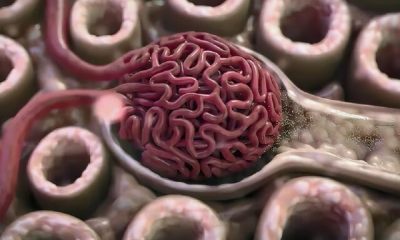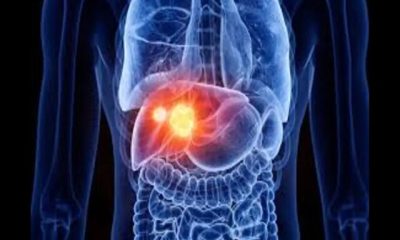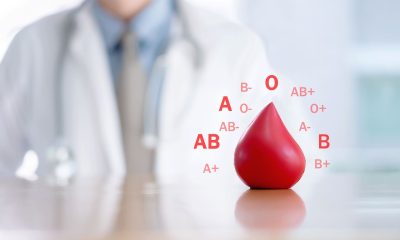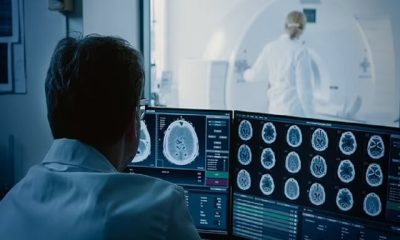Health
Why are some people always tired?
Published
1 month agoon


Why are some people always tired?
“Most days I stick to my routine, especially sleep,” says BBC journalist Sandy Ong. Before I feel tired, I get ready for bed, put on my pajamas, brush my teeth and do my skincare routine. “I put my phone away from me in the dining room, then go to my bedroom, which is quiet, dimly lit, and the right temperature, and read a story for half an hour before turning off the lights around 11 p.m.”
Eight and a half hours later, the alarm goes off and I wake up feeling exhausted,” Ong adds. I’m in early middle age, exercise regularly, and as far as I know, healthy. So why do I still feel tired when I wake up despite getting enough sleep?”
Many people experience the feeling of constant fatigue. According to a meta-analysis published in 2023 that examined 91 studies from three continents, one in five adults worldwide had experienced general fatigue for up to six months, despite not having an underlying medical condition. In the United States, 44 percent of more than 1,000 adults surveyed by the National Sleep Foundation in 2019 said they felt sleepy between two and four days a week. A 2022 YouGov survey of around 1,700 people found that one in eight UK adults are always tired and a quarter feel tired more often. Fatigue was higher in women regardless of whether they had children or not, and this finding was repeated in different studies.
Ambiguous concept
Rosalind Adam, a family doctor who has practiced in Aberdeen, Scotland for more than a decade, says fatigue is a very common complaint among her patients. This condition is so common that the National Health Service has even given it a name: TATT (Tired All The Time).
Despite the prevalence of chronic fatigue, scientists’ understanding of fatigue, what causes it, how it changes our bodies and brains, and how best to deal with it is limited. Even defining fatigue has been difficult. Adam explains that fatigue is different from sleepiness, which is more of a desire to sleep. Of course, the two are related, but fatigue is more multidimensional.
 Poor quality sleep can contribute to feeling tired.
Poor quality sleep can contribute to feeling tired.
“We can feel tired in many ways,” says Christopher Barnes, a professor of organizational behavior and management at the University of Washington in Seattle who studies how sleep deprivation affects the workplace. For example, there is physical fatigue, which is the type of tiredness you might feel after a long walk or intense exercise session. Vicki Whitmore, director of a program at the National Institutes of Health in Bethesda, Maryland, that studies the biology of fatigue, explains that fatigue is normal physiologically. It’s easy to understand, and researchers have been studying muscle fatigue for a long time.
Fatigue at work affects performance and leadership
Fatigue can have both cognitive and emotional aspects, which explains why when we’re tired, we may experience brain fog and find it difficult to do things or snap at people around us.
In the past decade, scientists have finally been able to study other aspects of fatigue thanks to advances in imaging technologies and biochemical tests that allow us to see brain changes in real-time, Whitmore says.
Fatigue can be caused by a myriad of reasons. Fatigue is a symptom of many diseases and chronic problems, including cancer, MS, long-term COVID, depression, and myalgic encephalomyelitis. Fatigue can also be caused by less serious causes. Adam, who studies how fatigue affects people with myeloma, heart failure and prolonged covid at the University of Aberdeen, says: “It’s important to distinguish between disease-related fatigue and non-disease-related fatigue. “If we can distinguish between different types of fatigue, we may be able to deal with them differently and offer solutions tailored to each.”
The importance of sleep quality
The benefits of adequate sleep have been repeatedly emphasized (the amount of sleep adults need varies, but most people need seven or more hours of sleep a night, and experts recommend 7 to 9).
Without sleep, our body will not be able to repair muscles, strengthen immunity, regulate emotions, consolidate memories and new information, and other important things. People who feel tired for long periods of time have a higher risk of death than the general population and are also at a higher risk of developing anxiety and depression.
In some cases, fatigue is a symptom of illness
Inadequate rest can lead to headaches and other physical pains, as well as feelings of irritability, low mood, and unfocused mental state. These effects often affect our relationships as well. Barnes says: “We know from scientific works related to sleep and marital satisfaction that when one of the couples suffers from lack of sleep, the conflict between them increases.”
Fatigue can also have a negative impact on the workplace and affect performance and leadership. Barnes was the first to examine how sleep-deprived bosses are more likely to be harsh with their employees. “They come into work with less self-control and are more likely to engage in abusive supervision,” she says.
Fatigue can also have devastating consequences. In the UK, fatigue is the main cause of 20% of accidents on major roads. Human error related to fatigue or lack of sleep has also been involved in many human-caused disasters, including the Challenger space shuttle explosion and the Exxon Valdez oil spill, along with other factors.
Ranjana Mehta, a professor of industrial and systems engineering at the University of Wisconsin-Madison who studies occupational fatigue, says: “Fatigue in oil and gas extraction work, both onshore and offshore, leads to significant disasters, loss of life, damages It has become economic and environmental problems that we are still involved in.”
But getting enough sleep is only part of the equation. Sleep quality is also important. “Better but shorter sleep is better than longer but poor quality sleep,” says Whitmore. “If your sleep is interrupted frequently, you will feel less refreshed.”
When we sleep, the brain stops external processes. Resting neurons create space for the cerebrospinal fluid that surrounds the brain to clear away waste products, such as the sticky amyloid-beta plaques associated with Alzheimer’s disease. This waste removal system is called the glymphatic system. During sleep that is continuously interrupted and ineffective, many toxins are not cleared from the brain.
Daniel Jane Blum, a sleep psychologist and research assistant professor at New York University Shanghai, says that our glymphatic system works best at certain times of the day each day, so it’s best to get deep sleep at regular times.
 Sleep that is constantly interrupted is not very relaxing.
Sleep that is constantly interrupted is not very relaxing.
Sleep time is important. Synchronizing sleep with our natural circadian rhythms (the brain’s 24-hour internal clock that regulates sleep-wake cycles) results in the best rest. This explains why night work is often associated with adverse health outcomes, from heartburn to diabetes.
Better but shorter sleep is better than longer but poor-quality sleep
Referring to the fourth and final stage of the sleep cycle, which is characterized by rapid eye movements during which we usually dream, our neural connections are strengthened and we process the emotions of the day, Bloom says that if you have the same eight hours of sleep but during the circadian period If it is not regular, you will have almost no REM sleep and you will not benefit from its benefits. Too little or irregular REM sleep has been linked to depression, dementia, Parkinson’s, and other cognitive problems.
Why are some people always tired?
Countless Reasons
Given the pervasive effects of poor quality sleep on our health, relationships, and work, it’s important to try to get to the root of the problem. When patients complain of persistent fatigue, the first thing Adam does is rule out possible medical causes.
Blood tests can sometimes be helpful in accurately diagnosing thyroid disorders or estrogen or other hormone imbalances. These conditions, especially in women, are often associated with feeling tired. Tests can also show if you are deficient in certain nutrients, such as vitamin B12, and folate, or minerals such as iron and magnesium. “Nutrient deficiencies play a significant role in fatigue,” says Geir Bjorklund, founder of the Norwegian Council for Nutritional and Environmental Medicine. “Essential nutrients such as vitamins, minerals, and dietary components are critical for various physiological processes, including energy metabolism.”
 Sleep is more effective if you go to bed at a certain time every day.
Sleep is more effective if you go to bed at a certain time every day.
Blood tests don’t tell everything, so it’s important to get a thorough clinical history. “In healthy people, we look at the role of factors such as exercise, sleep, diet, and mental health, and consider factors that may be important for each individual,” says Adam. “For example, a person may have a young child who makes it impossible for them to sleep continuously.”
One of the common causes of fatigue is sleep disorders or breathing problems
Stress also plays an important role in fatigue. A 2022 study of more than 16,200 government employees in China found that those who had experienced stressful life events were twice as likely to report feeling tired than others.
When we are stressed, the body produces the hormone cortisol, which increases our body temperature and heart rate to prepare us to face the threat. Cortisol levels naturally fluctuate throughout the day, but when levels remain consistently high, they disrupt sleep.
A common cause of fatigue, Bloom says, is sleep disorders or breathing problems. This problem includes snoring, which occurs when a person’s airway is partially or completely blocked. Referring to a disorder that causes breathing to stop and start repeatedly during the night, he said that all snoring is abnormal and may be a sign of sleep apnea. All of these can disrupt natural sleep patterns and make it impossible to reach deep sleep. Therefore, people sleep for seven to nine hours, but their sleep is not of high quality.
Dehydration is another major cause of fatigue. Other common causes include caffeine and alcohol, which people often underestimate their impact on their sleep quality. For example, the half-life of caffeine is about 5 hours, which means that when you drink a cup of coffee at noon, a quarter of it is still in your body by midnight.
Alcohol, especially near bedtime, can negatively affect sleep quality in several ways: aggravating breathing problems, disrupting the circadian cycle, and preventing REM sleep. You may often fall asleep a little faster and sleep more deeply during the first sleep cycle. But then it takes us into the lightest stage of sleep, causing more wakefulness and more cortisol production throughout the night.
Bjorklund recommends having a balanced diet, addressing nutritional deficiencies, maintaining good sleep hygiene, managing stress through techniques such as mindfulness, regular physical activity, ensuring adequate hydration, considering therapeutic interventions such as cognitive behavioral therapy, and creating a support network, to boost energy levels. it helps.


You may like


Why do people listen to sad songs?
There is a paradox in sad music: we don’t enjoy sadness in real life, but we enjoy art that makes us feel that way. Countless researchers since Aristotle tried to solve this contradiction. Perhaps through music, we experience a kind of catharsis of negative emotions. Catharsis here means refinement and cultivation of the soul. Maybe there is an evolutionary advantage in this feeling of sadness, or maybe we want to value our suffering. Maybe our body produces hormones in response to anxiety disorder, music that leads to a sense of comfort.
According to the New York Times, Dr. Nob, an experimental philosopher and psychologist at Yale University, in a new study published in the Aesthetic Education Journal, raised the question, “What is the purpose of sad music?” He tried to solve the contradiction of this kind of music. Over the years, he came to the conclusion that people often have two perceptions of the same thing. For example, they can consider people as artists if they have a set of characteristics such as an innate talent for working with a brush; But if they don’t have abstract values such as creativity, curiosity or interest and just recreate old masterpieces for profit, we can say they are not artists. According to Dr. Nob and his former student Tara Venkatsan, a cognitive scientist, perhaps sad music also has a dual nature.

The aforementioned research shows that our emotional response to music is multidimensional; You don’t necessarily feel happy when you listen to a beautiful song, and you don’t necessarily feel sad when you listen to a sad song. According to a 2016 study, the emotional response of 363 listeners to sad songs was divided into three categories: sadness and strong negative emotions such as anger, panic, and despair, nostalgia, quiet sadness and self-compassion, and finally sweet sadness is pleasant pain. It comes from consolation and understanding. Many respondents reported a combination of all three. The researchers called this research “Fifty Blue Spectrums”.
Given the layers of emotion and the ambiguity of language, it’s no wonder that sad music creates a paradox; But it is not clear why it induces a sense of pleasure or meaning. Some psychologists have investigated how certain aspects of music, such as position, pitch, rhythm, and resonance, are related to listeners’ emotions. According to research, certain forms of songs have an almost universal function: for example, among different countries and cultures, lullabies have similar acoustic characteristics that make children and adults feel safe. Thomas Irola, a musicologist at the University of Durham in England and researcher of the “Fifty Spectrum” study, says:
Throughout life, we learn to make connections between our feelings and what we hear. We recognize emotional expression in speech, and often these cues are used in a similar way in music.
Other researchers, such as Patrick Joslin, a music psychologist from Uppsala University in Sweden, believe that such findings reveal the value of sad music. Sad music, he writes in an essay, asks why “the second movement of Beethoven’s Eroica symphony evokes a sense of sadness?” It leads to the question, “Why does a slow step lead to a feeling of sadness?”
According to the findings of Joslin and his colleagues, there are cognitive mechanisms through which feelings of sadness are induced in listeners. These mechanisms include unconscious reactions in the brain stem, synchronization of the rhythm with the internal rhythm such as the heartbeat, conditional reactions to certain sounds, the arousal of memories, emotional contagion, and reflexive measurement of music. Perhaps because sadness is such a strong emotion, it can evoke an empathetic and positive response. In fact, understanding other people’s grief provokes a social response.
Why do people listen to sad songs?
The purpose of listening to sad music is not necessarily to convey sadness; Rather, it is creating a sense of connection.
Dr. Nob, along with Dr. Venkatsan and George Newman, a psychologist at the Rotman School of Management, designed a two-stage experiment to test the hypothesis. In the first part of the experiment, they gave one of four song descriptions to more than 400 participants. In the description of the first song, it was written: “transmitting complex and deep emotions, but technically full of errors.” The second track was described as: “music without technical errors that do not convey complex and deep emotions.” The third song was described as “highly emotional and technically flawless” and the fourth song was described as “technically flawed and non-emotional”.

Subjects were asked to indicate on a seven-point scale whether their song conveyed the intent of the music or not. Their goal was to show how important it is for music to express emotion and generally happiness, sadness, hate, or any other emotion on an intuitive level. Overall, subjects reported that deeply emotional but technically flawed songs best reflected the nature of music. In other words, the emotional expression had a more prominent value than the technical aspect.
In the second part of the experiment, which included 450 new subjects, the researchers gave each participant 72 descriptions of emotional songs that convey feelings such as “humiliation,” “narcissism,” “inspiration,” and “lust.” For comparison, they gave participants phrases that convey conversational interaction in expressing people’s feelings. For example, one of the phrases was: “An acquaintance is talking to you about the past week and his feeling of passion”. In general, the emotions that the subjects receive are strongly rooted in the “purpose of the music” and are similar to the emotions that make people feel close to each other in conversation: emotions such as love, joy, loneliness, sadness, ecstasy, and relaxation.
Mario Etti Picker, a philosopher at Lowell University of Chicago, finds the results of this study interesting. After reviewing the data, he came up with a relatively simple idea: “Perhaps the reason we listen to music is not just an emotional response, but we do it to understand the connection with others; Because, according to the reports of many subjects, sad music is not necessarily enjoyable despite its artistic dimensions. In other words, according to the paradox of sad music, our love of music is not the result of direct praise of sadness; Rather, it is the result of valuing communication with others.”
Dr. Irola also concluded in his research that empathic people are likely to be moved by unfamiliar sad music. They tend to engage in this kind of imaginary grief. These people also show significant hormonal changes in response to sad music. But sad music, like an onion, has many layers, and this explanation can give rise to other questions. For example, who should we communicate with? Artist or with our own past? Or even with an imaginary person?
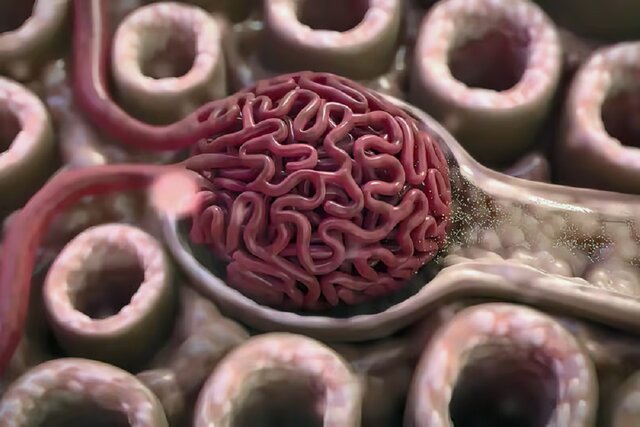

A new drug developed to treat severe influenza works in a unique way, unlike what a drug would expect, to treat lung disease and infection.
Inventing a new drug to treat influenza!
A new drug to treat severe flu successfully keeps patients at the right level of lung inflammation to protect against lung damage while still allowing the immune system to fight infection. This drug has been effective in mice even a few days after infection.
According to New Atlas, if you’ve ever had the flu, you’ve most likely contracted the influenza A virus (IAV). Compared to influenza B virus, infection with type A often causes more severe symptoms. But, while many of us have experienced the fever and chills, headache and muscle aches, fatigue, sore throat, and cough of the common flu, severe infection with the animal IAV strain is different and potentially life-threatening.
Severe infection of this type of influenza causes a special type of cell death called necroptosis in infected cells. While this is a natural process designed to limit viral spread by actively eliminating infected cells and mobilizing the immune system to respond, necroptosis can activate a hyperinflammatory response and cause collateral lung damage that is potentially fatal. Is. Other than managing its symptoms, there are few treatment options for treating severe influenza.
In a new study, researchers from Tufts University School of Medicine, St. Jude Children’s Research Hospital, the University of Houston, and Fox Chase Cancer Center collaborated to test a drug called UH15-38 that could prevent this flu-related lung damage in mice. It prevents and allows the immune system to fight the virus.
“Our drug significantly increased survival and reduced symptoms of influenza virus infection,” said Paul Thomas, co-author of the study. The new drug reduced dangerous inflammation and even seemed to improve the adaptive response to the virus.
Achieving the Goldilocks effect, or the effect of the right amount of the drug on inflammation, required researchers to use clever chemistry along with a thorough understanding of the underlying mechanisms of necroptosis.
Receptor-interacting protein kinase 3 (RIPK3) is an essential part of the necroptosis cell death pathway, but it also controls another cell death pathway called apoptosis. Both types of cell death trigger opposing immune responses. Apoptotic death usually results in muted immunological responses, while necroptosis releases molecules that cause inflammation. UH15-38 was designed to prevent the stimulation of the necroptosis pathway by RIPK3, while still allowing cell death and removing infected cells in a less inflammatory manner.
Alexei Degterev, an associate professor of developmental, molecular, and chemical biology at Tufts University School of Medicine and one of the authors of the paper, says: “If you eliminate necroptosis, you will still limit virus replication without severe damage to the lungs.” Necroptosis does not appear to be necessary to limit viral activity, so if we can block it, we can protect the host by reducing inflammation in the lungs.
Read more: Testing a vaccine that reduces liver tumors
The researchers tested the drug UH15-38 in mouse models and found that high doses of the drug provided protection against the usually fatal IAV influenza. At low doses, the UH15-38 drug protected mice against similar amounts of influenza that humans experience. Notably, the mice were protected even if they received the drug several days after being infected with the disease.
“This drug can do something we haven’t seen before,” says Thomas. We can start five days after the initial infection and still see benefits. Completely removing the RIPK3 protein is not a great choice because then the immune system cannot clear the virus. When we removed only the necroptosis, the animals did better because they still had apoptosis and could still get rid of the infectious cells, but their condition was not as severely inflammatory.
UH15-38 improved survival by preventing collateral necroptosis damage to type 1 alveolar epithelial cells, a special type of cell in the lungs that facilitates gas exchange. Damage to these cells can make it difficult for oxygen to enter the blood and carbon dioxide from it, and cause symptoms such as shortness of breath, wheezing, and chest tightness. The drug also reduced the number of immune cells associated with inflammation, such as neutrophils, in the mice.
Often, the worst part of the flu happens after the virus is under control when inflammation destroys lung cells, Thomas says. UH15-38 can reduce influenza-induced inflammation while leaving viral clearance and other functions of tissue and immune responses intact. This makes the drug a promising option to move towards clinical use.
The next step is clinical and human trials safely. Researchers are testing whether UH15-38 is effective in treating other respiratory diseases.
While the worst of COVID-19 may be upon us, another pandemic is expected, and we need something that protects the host regardless of how it is infected, Degtref says. This study demonstrates the possibility of achieving such a goal and renews interest in how cell death occurs against infections.
This study was published in the journal Nature.


Testing a vaccine that reduces liver tumors. A combination of a vaccine and an immunotherapy drug has reduced advanced liver cancer in trials.
Testing a vaccine that reduces liver tumors
A third of patients with advanced liver cancer who received a personalized vaccine in a small trial saw their liver tumors shrink.
According to IA, Geneos Therapeutics has announced the publication of positive safety data, immunogenicity, and effectiveness of its solution in Nature Medicine magazine.
According to this study, hepatocellular carcinoma is the most common type of primary liver cancer and is also one of the leading causes of cancer-related deaths worldwide. The disease is responsible for more than 12,000 deaths each year in the United States alone.
Hepatocellular carcinoma or hepatocellular carcinoma (HCC) is the most common type of primary liver cancer in adults and is currently the most common cause of death in people with cirrhosis. This disease is the third leading cause of cancer deaths worldwide.
Hepatocellular carcinoma occurs in conditions of chronic inflammation of the liver and is most associated with chronic viral hepatitis infection (hepatitis B or C) or exposure to toxins such as alcohol, aflatoxin, or pyrrolizidine alkaloids.
Although advances have been made in the treatment of advanced liver cancer, the five-year survival rate remains below 10%.
current study
The first and last patients were enrolled in the study on June 16, 2020, and June 14, 2023, respectively, and all 36 patients in this study received their personalized vaccine.
In this study, researchers used samples from patients’ tumors to make vaccines based on the new mutations found in each patient’s tumor.
Liver cancer contains fewer mutations that reduce the effectiveness of immunotherapies. The results show that vaccines based on mutations present only in the patient’s tumor can boost the immune system. This is done in a way that improves the ability to detect and attack cancers.
The vaccine essentially trains the immune system to recognize antigens that are being ignored, says Dr. Mark Yarkwan, who led the study.
Read more: The relationship between high blood insulin levels and pancreatic cancer
Patients were given vaccines along with widely used immunotherapy. With this combination, they experienced a 30% tumor reduction. Three of them had a complete response, meaning no detectable signs of tumor remained after a median follow-up of 21.5 months.
“This certainly shows that the vaccine has indeed increased clinical efficacy,” Yarkvan added.
Side effects and adverse reactions
There were no serious side effects for the patients, and the only complication was pain at the injection site.
Genius’ innovative treatment involves a DNA vaccine that delivers the genetic code of mutated proteins to cells via a tiny electrical impulse. Each vaccine can target up to 40 mutated genes.
Despite the small size of the study, its results are important for the advancement of the field, says Niranjan Sardsai, president of Genius. “Our mechanism validates every step from vaccination to tumor reduction that is necessary to explain the immunological basis of the observed clinical responses,” he said in a statement.
Yarkvan also said that larger trials were being planned, but declined to provide details.
According to this study, more than 800,000 people worldwide are diagnosed with this type of cancer every year. It is also the leading cause of cancer deaths worldwide and accounts for more than 700,000 deaths annually.
It is predicted that the number of new cases of liver cancer will increase by about 55% each year between 2020 and 2040. It is also predicted that 1.3 million people will die from liver cancer in 2040.
Preliminary findings of the study were presented at the American Association for Cancer Research in San Diego.


What is an exoplanet? Everything you need to know


Seven surprising discoveries about the planet Mercury


Why there is no gaseous moon in solar system?


The strangest things that can happen to humans in space


Motorola Edge 50 Ultra review


The secret of the cleanest air on earth has been discovered


Asus Zenbook 14 OLED laptop review


Motorola Edge 50 Pro


How extinct animals could be brought back from death?


Healing diabetic wounds with bacteria-killing hydrogel
Popular
-



 Technology9 months ago
Technology9 months agoWho has checked our Whatsapp profile viewed my Whatsapp August 2023
-



 Technology10 months ago
Technology10 months agoHow to use ChatGPT on Android and iOS
-



 Technology9 months ago
Technology9 months agoSecond WhatsApp , how to install and download dual WhatsApp August 2023
-



 Technology11 months ago
Technology11 months agoThe best Android tablets 2023, buying guide
-



 Humans1 year ago
Humans1 year agoCell Rover analyzes the inside of cells without destroying them
-



 AI1 year ago
AI1 year agoUber replaces human drivers with robots
-



 Technology10 months ago
Technology10 months agoThe best photography cameras 2023, buying guide and price
-



 Technology11 months ago
Technology11 months agoHow to prevent automatic download of applications on Samsung phones



